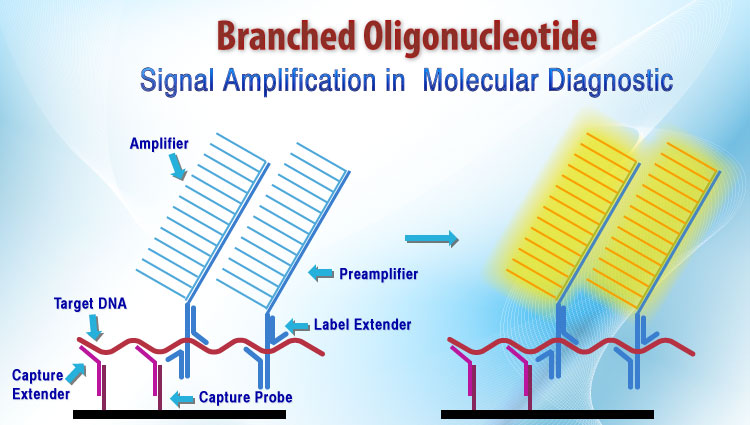Bio-Synthesis offers one of the largest selection of modifications for DNA and RNA synthesis. We provide branched DNA (bDNA) synthesis using 5-Me-dC Brancher to produce a multimer comb-like constructs1 which can be use to amplify the signal output in raid non-radioisotopic nucleic acid hybridization assay.
The ability to obtain enough copies of amplified target sequences for signal to be observed in the conventional detection system is critical in molecular diagnostic assays. However, direct analysis of the target DNA by signal amplification offer an alternative approach. During the method of using branch DNA oligonucleotide (bDNA), a 'amplification multimers' contains a primary sequence that binds directly or indirectly to the target nucleic acid and a set of secondary sequences complementary to the labeled oligonucleotide. First the amplification multimer is hybridized to the target then multiple copies of the labeled probe are bound to the multimer. The signal amplification achieved is based upon the number of secondary sequences in the polymer. bDNA technology for detection of nucleic acid target molecules are sensitive, specific, and reliable tools in the diagnosis of viral and bacterial infections and for monitoring disease progression during the course of therapy. bDNA tests have evolved from developmental stages in the research laboratory to US Food and Drug Administration–approved quantitative assays with valuable clinical applications. The bDNA assays are less labor-intensive than many molecular-based procedures because they are highly amenable to total automation. Using bDNA, amplification of a target sequence is not required, and, thus, cross-contamination between replicate samples due to excessive amplicons or carryover is less likely in bDNA assays. In addition, because bDNA is a signal amplification technology, the assay is able to quantify with less than a 0.5 log or 3-fold variability for its entire dynamic range.
Branch Oligonucleotides

bDNA technology has proved versatile because methods have been developed for the detection of various infectious diseases. However, more recent efforts have focused on the development of bDNA assays for the quantification of HIV-1 and hepatitis C virus (HCV) RNA, leading to the routine application of bDNA methods in the clinical molecular diagnostics laboratory.
Inquire custom branch oligonucleotide synthesis
References:
1. T. Horn and M.S. Urdea, Nucleic Acids Res, 1989, 17, 6959-67.
2. M.L. Collins, et al., Nucleic Acids Res, 1997, 25, 2979-84.
3. G. Tsongalis, Am J. Clinical Pathology 2006, 126:448-453